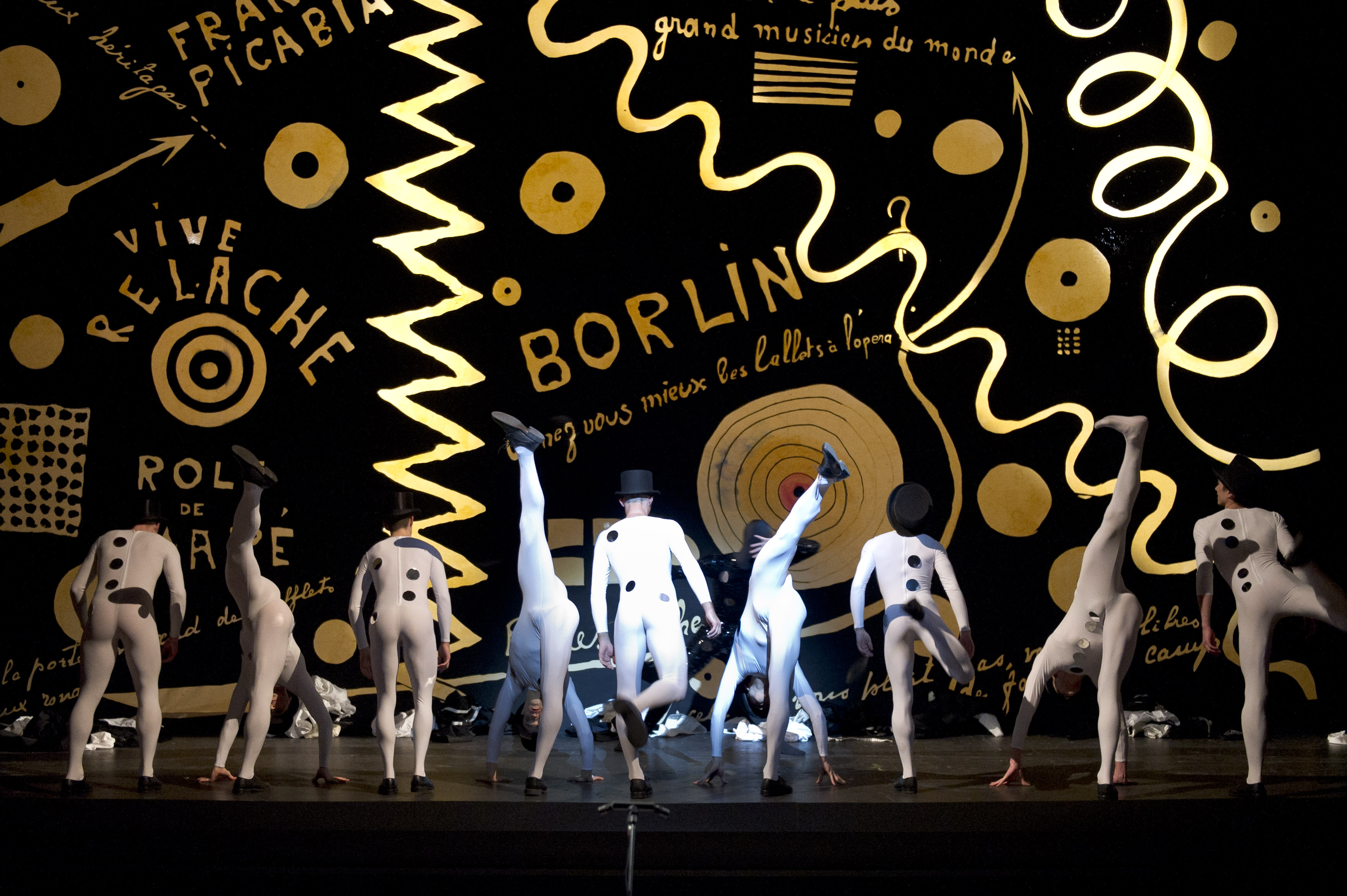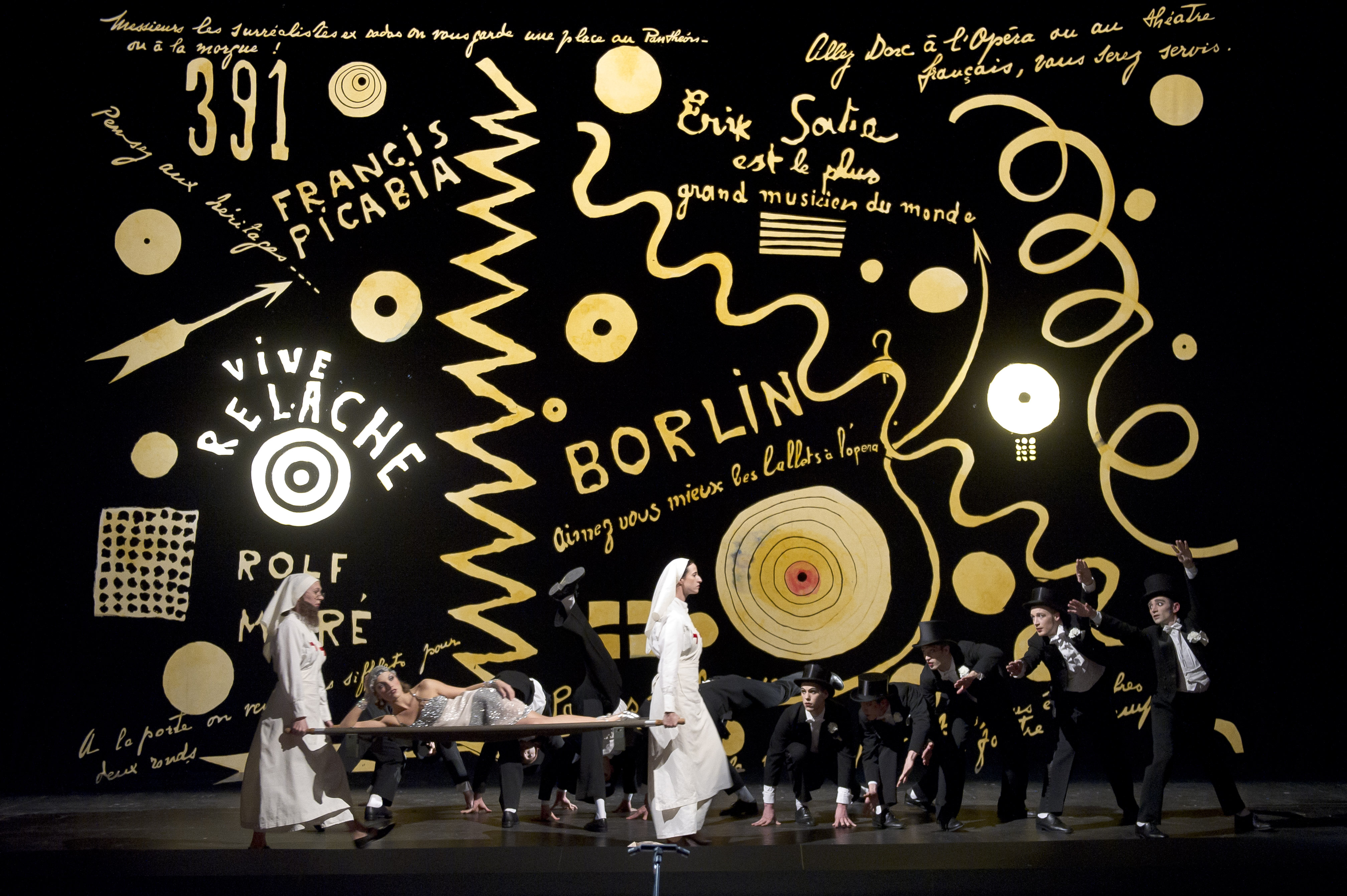Relâche
Relâche
Reenactment in March 2014, at the Opéra national de Lorraine (Nancy)
Photo © Laurent Philippe
14 DANCERS / 41 MINUTES
« 1924 was a particularly wonderful year for the man who declared: “I have always loved playing seriously.” Francis Picabia (1879- 1953), the indefatigable artist, writer and enthusiastic letter writer, was working on 391, an avant-garde Paris revue, using it that year to fight on two separate fronts: the academisation of Dada, which he dismissed with one of his polemical, brutally funny texts, and the pretentions of the nascent surrealism of André Breton, which he suspected was only a pathetic means of seizing power in the Parisian art world. He drew, he painted, he chatted with his co-conspirators Marcel Duchamp and Man Ray and between the laughter and the tears, found the time to work on Relâche or on editing his one novel, Caravansérail, which was both autobiographical and lost for a long time, it was only finally published after his death.
With devastating cynicism, incomparable lucidity and humour, this Satyricon of modern times is that of an actor and spectator who sends up, sends off and records with jubilation the day’s current inventions and disorders, settling scores, denouncing fakes, blow-hards and pretenders. An ode to movement and to moments of everyday life, between dinners at Prunier and unbridled delights, jazz bands and the new dances, roulette at Monte-Carlo, exhibitions and visits, opium, car races or spiritualism seances at his home on the rue Fontaine, Picabia intertwines the art scene and the Parisian nightlife of the 20’s, mocking André Breton, costing out Eros and blasting the fake values of the artists sucking up to the powers that be.

Caravansérail is a literary gem, and Relâche would be the same thing onstage. Both the novel and the dance work show us what it was like at that time, when all of Paris was a party, as Hemingway wrote. This was the time, set during the period between the two World Wars, at the exact moment when the conventions of bourgeois humanism inherited from the 19th century were collapsing, precipitated by the events of 1914-18 and by the arrival of European fascism and the Nazis, at the end of the international economic debacle which came about after the crash of 1929. Walking on this tightrope strung between two eras, when the dreams of the new Man were flourishing with the art happening all over Europe, from France to Germany, from Italy to Hungary, from Holland to Russia, between Dada, Bauhaus and Constructivism, the renewal of these art forms resonated for Picabia and his friends with the renewal of certain forms of life. »
Relegating old forms of blackmail to what he termed “eternal beauty,” to “noble or overly solemn subjects,” it was with ferocity and humour that the man who declared that he preferred “a chair at the Paris Casino to one at the Académie Française,” attacked the art that had become a mere accessory or a piece of bourgeois furniture – a lie which could be bought, a conveyor of conventions, whose declared romanticism or rebellion against command would set off corrosive yet always joyful salvos.
As for Relâche, it was with the complicity of his elder in salutary insolences, Erik Satie, that Picabia conceived it, along with the young, elegant René Clair, an art critic and writer in a sleeping Paris, a director who was an intact breath of freshness, whom he asked to direct the Entr’acte cinématographique which he had sketched out. And Jean Börlin, the dancer and official Swedish choreographer - was assigned the task of translating onto the bodies a part of the choreography of the piece, which was otherwise taken care of by the overwhelming kineticism of the scenographic art object he conceived of as a set, somewhere between blinding sculpture and flashing luminous tableau. He was asked to speak three of the most familiar languages spoken by audiences in certain dark Parisian theatres of the time – music hall, circus and ballet – to twist them into a sort of braid in which quotes and puns and insinuations of a deliberate casualness would undo the normal hierarchies and communicate his enigmas. Between collage and montage and these newer procedures of the art of that time, the curtain went up on a fiction. And while the “bride” of art, once “stripped naked by its bachelors,” gets dressed in order to later undress them – it is to the audience that Picabia asks this question: what is the Entr’acte (something taking place between two acts) for those who are on Relâche (in French the word means a day of no performance, or that the theatre is closed)?"
Christophe Wavelet

Petter Jacobsson et Thomas Caley
The choreographers and dancers Petter Jacobsson and Thomas Caley, started collaborating in the nineteen nineties, choreographing works for Martha@Mother, the Joyce Soho in New York and the opera Staden for the Royal Opera House in Stockholm, a commission for the 1998 Cultural capital of Europe. For the Royal Swedish Opera, Ballet and Orchestra they created two immense Happenings, In nooks and crannies 2000 and 2001. The two different performances, occupied non-traditional performance spaces throughout the entire theatre.In 2005 they started their own company creating works entitled Nightlife, Untitled partner, Flux, No mans land - no lands man and The nearest nearness. In 2002 they received a “Goldmask” for the musical Chess with Björn Ulveus and Benny Andersson (ABBA).
As of 2011, Petter is choreographer and the Artistic Director and Thomas choreographer and the Coordinator of Research for the Centre Chorégraphique National - Ballet de Lorraine, Nancy. For the company they have created Untitled Partner #3, Performing Performing, Relâche, Armide, Discofoot, L’Envers, Record of ancient things, Happening Birthday, For Four Walls and Air- Condition.
Their programming for the CCN is organized around questions or themes and each year they invite a wide variety of artists both French and international to play and question within them. Their first programming season 2012, was entitled La saison de La. There they asked why is it Le Ballet but La dance? In response to this question of gender they presented solely female choreographers of diverse backgrounds. The season Tête à tête à têtes was a dialog focused on our modernity and its influences and connections with contemporary artists and spectators. Live! was a celebration of the ephemerality of the performing arts. Together with the continuing seasons, Folk + Danse = (R) évolution, Unknown Pleasures, 50 ans!, Fifty Plus, Unseless beauty, Fiction Addiction and Ready! (Made), all have continued to challenge, celebrate and question. To insure a continued lively and non fixed use of the artform they have also worked with the Musée d’Art Moderne in Paris and Centre Pompidou- Metz and Paris, and an original initiative LAB-BLA-BAL, a series of discussions and open house art experiments.
Francis Picabia
Francis Picabia, (born January 22, 1879, Paris, France— died November 30, 1953, Paris), French painter, illustrator, designer, writer, and editor, who was successively involved with the art movements Cubism, Dada, and Surrealism.
Picabia was the son of a Cuban diplomat father and a French mother. After studying at the École des Arts Décoratifs (1895–97), he painted for nearly six years in an Impressionist mode akin to that of Alfred Sisley. In 1909 he adopted a Cubist style, and, along with Marcel Duchamp, he helped found in 1911 the Section d’Or, a group of Cubist artists. Picabia went on to combine the Cubist style with its more lyrical variation known as Orphism in such paintings as I See Again in Memory My Dear Udnie (1913–14) and Edtaonisl (1913). In these early paintings he portrayed assemblages of closely fitted, metallic-looking abstract shapes. As Picabia moved away from Cubism to Orphism, his colours and shapes became softer.
In 1915 Picabia traveled to New York City, where he, Duchamp, and Man Ray began to develop what became known as an American version of Dada, a nihilistic art movement that flourished in Europe and New York from 1915 to about 1922. In New York Picabia exhibited at Alfred Stieglitz’s gallery, 291, and contributed to the proto-Dadaist review 291. About 1916 he gave up the Cubist style completely and began to produce the images of satiric, machinelike contrivances that are his chief contribution to Dadaism. The drawing Universal Prostitution (1916–19) and the painting Amorous Procession (1917) are typical of his Dadaist phase; their association of mechanistic forms with sexual allusions were successfully shocking satires of bourgeois values.
In 1916 Picabia returned to Europe. He settled in Barcelona, where he published the first issues of his own satiric journal 391 (named in reference to the New York review). He subsequently joined Dadaist movements in Paris and Zürich. In 1921 he renounced Dada on the grounds that it was no longer vital and had lost its capacity to shock. In 1925 he left Paris to settle in the south of France, where he experimented with painting in various styles. He returned to live in Paris in 1945, and he spent the final years of his life painting in a mostly abstract mode. Picabia was notable for his inventiveness, adaptability, absurdist humour, and disconcerting changes of style.
Les Ballets suédois
The Ballets Suédois was a predominantly Swedish dance ensemble based in Paris that, under the direction of Rolf de Maré (1888–1964), performed throughout Europe and the United States between 1920 and 1925, rightfully earning the reputation as a «synthesis of modern art».
The Ballets suédois created pieces that negotiated new terms of the post-World War I European imaginary by combining forms of “dance, drama, painting, poetry, and music with acrobatics, circus, film, and pantomime”.
Between 1920 and 1924, the ensemble performed 24 creative pieces, totaling 2,678 performances in 274 cities throughout twelve countries. The collaboration of the choreography of Jean Börlin, the artistic direction of de Maré, and the aesthetic framework of Fernand Léger, provided a rich intercultural crosssection of avant-garde performance in interwar Europe.
The company collaborated with some of the top creative talents in Paris for story creation, set design, and music composition. These included the poets Blaise Cendrars, Paul Claudel, Cocteau and Ricciotti Canudo; the composers Auric, Honegger, Milhaud, Cole Porter, Poulenc, and Satie; and the artists de Chirico, Fernand Léger, and Francis Picabia.
Visual design was a strong element in the company’s productions, sometimes overpowering the dancing. Börlin’s interest in primitive cultures, which was shared by many artists of the early 20th century, inspired La création du monde (1923). Its source, an African creation myth, was reflected in Milhaud’s jazz score and Léger’s designs, but most of the choreography was couched in the academic ballet technique. Börlin added a few original touches, however, such as the herondancers who moved on stilts.
The company’s last production was the Dadaist ballet Relâche (1924), whose title means a cancelled performance.
